Popular categories
Looking for a yarn?

Order DROPS Needles & Hooks
Clicking the ORDER button will redirect you to Wool Warehouse Direct Ltd website
Gypsy Blue
Crochet DROPS jacket worked in a circle in "Big Delight" and "Karisma". Size: S - XXXL.
DROPS design: Pattern no db-053
Yarn group C or A + A
----------------------------------------------------------
Size: S - M - L - XL - XXL - XXXL
Materials:
DROPS BIG DELIGHT from Garnstudio
300-400-400-500-500-500 g colour no 09, atlantis
DROPS KARISMA from Garnstudio
250-300-300-350-350-400 g colour no 60, blue turquoise
DROPS CROCHET HOOK SIZE 6 mm – or size needed to get 12 dtr in width x 4.5 dtr vertically alternately with 1 round Big Delight and 1 round Karisma = 10 x 10 cm.
-------------------------------------------------------
Alternative Yarn – See how to change yarns here
Yarn Groups A to F – Use the same pattern and change the yarn here
Yarn usage using an alternative yarn – Use our yarn converter here
-------------------------------------------------------

Order DROPS Needles & Hooks
Clicking the ORDER button will redirect you to Wool Warehouse Direct Ltd website
- English (UK/cm)
- Česky - not translated
- Dansk
- Deutsch
- Eesti keel
- English (US/in)
- Español
- Français
- Íslenska
- Italiano
- Magyar
- Nederlands
- Norsk
- Polski
- Português
- Suomi
- Svenska
- English (UK/cm), Bulgaria
- English (UK/cm), Croatia
- English (UK/cm), Greece
- English (UK/cm), Latvia
- English (UK/cm), Lithuania
- English (UK/cm), Romania
- English (UK/cm), Slovenia
- Česky, Slovakia - not translated
Pattern instructions
2 dtr tog into 1 dtr as follows: Work 1 dtr but wait with last YO and pull through, work 1 dtr in next st but pull last YO through all 3 sts on hook.
CROCHET TIP:
Replace first dtr on round with 4 ch. Finish with 1 sl st in fourth ch from beg of round.
----------------------------------------------------------
CIRCLE:
When piece is worked in the round, start with this technique to avoid hole in the middle (instead of ch-ring) use Big Delight: Hold the yarn end and wind the yarn one time around the index finger to make a loop. Hold the loop with left thumb and middle finger, place the yarn over left index finger. Insert hook through the loop, make a YO and pull yarn through loop, work 1 ch, then work around the loop as follows:
ROUND 1: 1 ch, 1 dc, 2 htr, 2 tr, 2 dtr. Insert 1 stitch marker in loop on last dtr so that it does not unravel and place yarn aside. Switch to Karisma and work as follows in loop: 1 dc, 2 htr, 2 tr, 2 dtr. Pull the yarn end to tighten loop. Fasten the yarn end on the back side.
ROUND 2: (Continue with Karisma). Work 1 dtr + 1 ch in each of the first 7 sts (= 1 dc, 2 htr, 2 tr and 2 dtr worked with Big Delight). Insert 1 stitch marker in loop on last dtr so that it does not unravel and place yarn aside. Continue with Big Delight. Work 1 dtr + 1 ch in each of the next 7 sts (= 1 dc, 2 htr, 2 tr and 2 dtr worked with Karisma) = 14 dtr + 14 ch.
ROUND 3: (Continue with Big Delight.) Work 1 dtr + 1 ch + 1 dtr + 1 ch in each of the first 7 dtr, insert 1 stitch marker in loop on last dtr so that it does not unravel and put yarn aside. Continue with Karisma, work 1 dtr + 1 ch + 1 dtr + 1 ch in each of the next 7 dtr = 28 dtr + 28 ch.
ROUND 4: (Continue with Karisma). * Work 1 dtr + 1 ch in the next dtr, work 1 dtr + 1 ch + 1 dtr + 1 ch in the next dtr *, repeat from *-* 7 times. Insert 1 stitch marker in loop on last dtr so that it does not unravel and place yarn aside. Continue with Big Delight. * Work 1 dtr + 1 ch in the next dtr, work 1 dtr + 1 ch + 1 dtr + 1 ch in the next dtr *, repeat from *-* 7 times = 42 dtr + 42 ch.
ROUND 5: (Continue with Big Delight.) * Work 1 dtr + 1 ch in each of the next 2 dtr, work 1 dtr + 1 ch + 1 dtr + 1 ch in the next dtr *, repeat from *-* 7 times. Insert 1 stitch marker in loop on last dtr so that it does not unravel and place yarn aside. Continue with Karisma. * Work 1 dtr + 1 ch in each of the next 2 dtr, work 1 dtr + 1 ch + 1 dtr + 1 ch in the next dtr *, repeat from *-* 7 times = 56 dtr + 56 ch.
Repeat 4th and 5th round but on every round work 1 dtr + 1 ch more between every inc = 14 dtr + 14 ch inc on every round. Continue until there are 112-112-126-126-140-140 dtr + 112-112-126-126-140-140 ch on round, circle measures approx. 20-20-23-23-25-25 cm from centre (= 40-40-46-46-50-50 cm in diameter).
Work next round as follows: (Continue with spiral and colour change but without inc.) Work 1 dtr + 1 ch in each of the first 16-16-18-18-20-20 dtr, work 24-24-28-28-32-32 loose ch for armhole, skip the next 16-16-18-18-20-20 dtr, work 1 dtr + 1 ch in every dtr until 32-32-36-36-40-40 dtr remain on round, work 24-24-28-28-32-32 loose ch for armhole, skip the next 16-16-18-18-20-20 dtr, work 1 dtr + 1 ch in each of the last 16-16-18-18-20-20 dtr.
Work next round as follows:
* Work 1 dtr + 1 ch in each of the next 7-7-8-8-9-9 dtr, work 1 dtr + 1 ch + 1 dtr + 1 ch in next dtr *, repeat from *-* 2 times, work 18-18-20-20-22-22 dtr with 1 ch between each around ch-space, * work 1 dtr + 1 ch in each of the next 7-7-8-8-9-9 dtr, work 1 dtr + 1 ch + 1 dtr + 1 ch in next dtr *, repeat from *-* 3 times. Insert 1 stitch marker in loop on last dtr so that it does not unravel and place yarn aside. Switch yarn. * Work 1 dtr + 1 ch in each of the next 7-7-8-8-9-9 dtr, work 1 dtr + 1 ch + 1 dtr + 1 ch in next dtr *, repeat from *-* 3 times, work 18-18-20-20-22-22 dtr with 1 ch between each around ch-space, * work 1 dtr + 1 ch in each of the next 7-7-8-8-9-9 dtr, work 1 dtr + 1 ch + 1 dtr + 1 ch in next dtr *, repeat from *-* 2 times = 126-126-140-140-154-154 dtr + ch on round.
Work as 4th and 5th round but on every round work 1 dtr + 1 ch more between every inc = 14 dtr + 14 ch inc on every round. Continue until circle measures 52-54-56-58-60-62 cm from centre (= 104-108-112-116-120-124 cm in diameter, or desired measurements).
Finish circle as follows: Continue with the same yarn as last round. Work 1 dtr in each of the next 2 dtr, 1 tr in each of the next 2 dtr, 1 htr in each of the next 2 dtr, 1 dc in next dtr, 1 sl st in next dtr, fasten off.
SLEEVES:
Work in the round from armhole and down. Use hook size 6 mm and beg with opposite colour of the one the last dtr around armholes was worked with. Work stripes, i.e. work 1 round with Karisma and 1 round with Big Delight - READ CROCHET TIP.
Work 36-38-40-42-44-46 dtr around the opening for sleeve, beg of round should be under sleeve. Then work 3 rounds with 1 dtr in every dtr. Continue with 1 dtr in every dtr - AT THE SAME TIME dec 2 dtr mid under sleeve - READ DECREASE TIP. Repeat dec every 8 cm 6 more times = 22-24-26-28-30-32 dtr. Continue to work until sleeve measures 54-55-54-55-54-55 cm. Fasten off. Work the other sleeve the same way.
Diagram

What can you do with our patterns? You can share DROPS patterns online, using the pattern original picture, materials, name and number. But you are NOT ALLOWED to reproduce the complete pattern digitally in any way. Yarn stores are welcome to use the DROPS pattern database to promote the sale of our assortment. You can print out our patterns, make as many copies as you’d like. The only thing we ask is that you don't make any changes / additions to the original printed document. And that the patterns according to the DROPS philosophy are given out to the consumers for free. Editorials that wish to publish our patterns in printed books or magazines can contact us for more information. The sale of garments based on DROPS patterns is permitted as long as they are sold as single items or per order. Further commercial use of the patterns is not permitted. It has to be clearly stated that the garment is made based on a design from DROPS DESIGN. The use of clothing labels of which DROPS DESIGN forms part is conditioned by the inclusion of the following text: “A DROPS DESIGN made by …..”. The use of DROPS photos for marketing purposes/sales is only permitted in connection with the use/sale of DROPS products. The photos may not be cut or edited and the logo should be clearly visible.
We reserve the right to withdraw the permission for use of our patterns at any time, notwithstanding the reason.
Each of our patterns has specific tutorial videos to help you.
These step-by-step tutorials might also help you:
Why is the knitting/crochet tension so important?
Knitting tension is what determines the final measurements of your work, and is usually measured per 10 x 10 cm. It is provided like so: number of stitches in width x number of rows in height - eg: 19 stitches x 26 rows = 10 x 10 cm.
The knitting tension is very individual; some people knit/crochet loosely while others work tightly. You adjust the knitting tension with the needle size, which is why the suggested needle size is only meant as a guide! You need to adjust this (up or down) to ensure that YOUR knitting tension matches the knitting tension provided in the pattern. If you work with a different knitting tension than provided you will have a different yarn consumption, and your work will have different measurements than what the pattern suggests.
The knitting tension also determines which yarns can replace each other. As long as you achieve the same knitting tension you can replace one yarn with another.
See DROPS lesson: How to measure your tension/gauge
See DROPS video: How to make a gauge tension swatch
How do I know how many balls of yarn I need?
The required amount of yarn is provided in grams, eg: 450 g. To calculate how many balls you’ll need you first need to know how many grams are in 1 ball (25g, 50g or 100g). This information is available if you click on the individual yarn quality on our pages. Divide the amount required with the amount of each ball. For example, if each ball is 50g (the most common amount), the calculation will be as follows: 450 / 50 = 9 balls.
Can I use a different yarn than what the pattern suggests?
The important thing when changing from one yarn to another is that the knitting/crochet tension remains the same. This is so that the measurements of the finished piece will be the same as on the sketch provided. It is easier to achieve the same knitting tension using yarns from the same yarn group. It is also possible to work with multiple strands of a thinner yarn to achieve the knitting tension of a thicker one. Please try our yarn converter. We recommend you to always work a test swatch.
Please NOTE: when changing yarn the garment might have a different look and feel to the garment in the photo, due to individual properties and qualities of each yarn.
See DROPS lesson: Can I use a different yarn than the one mentioned in the pattern?
What are the yarn groups?
All our yarns are categorised into yarn groups (from A to F) according to thickness and knitting tension – group A contains the thinnest yarns and group F the thickest. This makes it easier for you to find alternative yarns to our patterns, should you wish to switch yarn. All yarns within the same group have a similar knitting tension and can easily replace each other. However, different yarn qualities have different structures and properties which will give the finished work a unique look and feel.
How do I use the yarn calculator?
At the top of all our patterns you’ll find a link to our yarn calculator, which is a helpful tool should you wish to use a different yarn than suggested. By filling in the yarn quality you wish to replace, the amount (in your size) and number of strands, the calculator will present good alternative yarns with the same knitting tension. Additionally it will tell you how much you’ll require in the new qualities and whether you’ll need to work with multiple strands. Most skeins are 50g (some are 25g or 100g).
If the pattern is worked with multiple colours, every colour will have to be calculated separately. Similarly, if the pattern is worked with several strands of different yarns (for example 1 strand Alpaca and 1 strand Kid-Silk) you will have to find alternatives for each, individually.
Why do you show discontinued yarns in the patterns?
Since different yarns have different qualities and textures we have chosen to keep the original yarn in our patterns. However, you can easily find options among our available qualities by using our yarn calculator, or simply pick a yarn from the same yarn group.
It is possible that some retailers still have discontinued yarns in stock, or that someone has a few skeins at home that they would like to find patterns for.
The yarn calculator will provide both alternative yarn as well as required amount in the new quality.
What size should I knit?
If you think it's hard to decide what size to make, it can be a good idea to measure a garment you own already and like the size of. Then you can pick the size by comparing those measures with the ones available in the pattern's size chart.
You'll find the size chart at the bottom of the pattern.
See DROPS lesson: How to read size chart
Why do I get the wrong knitting tension with the suggested needle size?
The needle size provided in the pattern serves only as a guide, the important thing is to follow the knitting tension. And since knitting tension is very individual, you will have to adjust the needle size to ensure that YOUR tension is the same as in the pattern – maybe you’ll have to adjust 1, or even 2 needle sizes, up or down to achieve the correct tension. For this, we recommend that you work test swatches.
Should you work with a different knitting tension than the one provided, the measurements of the finished garment might deviate from the measurement sketch.
See DROPS lesson: How to measure your tension/gauge
See DROPS video: How to make a tension/gauge swatch
Why is the pattern worked top-down?
Working a garment top-down provides more flexibility and room for personal adjustment. For example it is easier to try the garment on while working, as well as making adjustments to length of yoke and shoulder caps.
The instructions are carefully explaining every step, in the correct order. Diagrams are adjusted to the knitting direction and are worked as usual.
How do I work according to a knitting diagram?
The diagram depicts all rows/rounds, and every stitch seen from the right side. It is read from bottom to top, from right to left. 1 square = 1 stitch.
When working back and forth, every other row is worked from the right side and every other row is worked from the wrong side. When working from the wrong side, the diagram will have to be worked reversed: from left to right, knit stitches are purled, purl stitches are knit etc.
When working in the round every round is worked from the right side and the diagram are worked from right to left on all rounds.
See DROPS lesson: How to read knitting diagrams
How do I work according to a crochet diagram?
The diagram depicts all rows/rounds, and every stitch seen from the right side. It is worked from bottom to top, from right to left.
When working back and forth every other row is worked from the right side: from right to left and every other row is worked from the wrong side: from left to right.
When working in the round, every row in the diagram are worked from the right side, from right to left.
When working a circular diagram you start in the middle and work your way outwards, counter clockwise, row by row.
The rows usually start with a given number of chain stitches (equivalent to the height of the following stitch), this will either be depicted in the diagram or explained in the pattern.
See DROPS lesson: How to read crochet diagrams
How do I work several diagrams simultaneously on the same row/round?
Instructions for working several diagrams after each other on the same row/round, will often be written like so: “work A.1, A.2, A.3 a total of 0-0-2-3-4 times". This means you work A.1 once, then A.2 is worked once, and A.3 is repeated (in width) the number of times provided for your size – in this case like so: S = 0 times, M = 0 times, L=2 times, XL= 3 times and XXL = 4 times.
The diagrams are worked as usual: begin with the first row in A.1, then work the first row in A.2 etc.
See DROPS lesson: How to read knitting diagrams
See DROPS lesson: How to read crochet diagrams
Why are the sleeves shorter in larger sizes?
The total width of the garment (from wrist-to-wrist) will be larger in the larger sizes, despite the actual sleeves being shorter. The larger sizes have longer sleeve caps and wider shoulders, so there will be a good fit in all sizes.
Where on the garment is the length measured?
The measurement sketch/schematic drawing provides information regarding the full length of the garment. If it’s a jumper or a jacket the length is measured from the highest point on the shoulder closest to the neckline, and straight down to the bottom of the garment. It is NOT measured from the tip of shoulder. Similarly, the length of yoke is measured from the highest point on the shoulder and down to where yoke is split into body and sleeves.
On a jacket measures are never taken along bands, unless specifically stated. Always measure inside band stitches when measuring the length.
See DROPS lesson: How to read a schematic drawing
What is a repeat?
Diagrams are often repeated on the round or in height. 1 repeat is the diagram the way it appears in the pattern. If it says to work 5 repeats of A.1 in the round, then you work A.1 a total of 5 times after/next to each other in the round. If it says to work 2 repeats of A.1 vertically/in height you work the entire diagram once, then begin again at the start and work the entire diagram one more time.
Why does the piece start with more chain stitches than it’s worked with?
Chain stitches are slightly narrower than other stitches and to avoid working the cast-on edge too tight, we simply chain more stitches to begin with. The stitch count will be adjusted on the following row to fit the pattern and measurement sketch.
Why increase before the rib edge when the piece is worked top-down?
The rib edge is more elastic and will contract slightly compared to, for example, stocking stitch. By increasing before the rib edge, you avoid a visible difference in width between the rib edge and the rest of the body.
Why increase in the cast-off edge?
It’s very easy to cast off too tightly, and by making yarn overs while casting off (and simultaneously casting these off) you avoid a too tight cast off edge.
See DROPS video: How to bind off with yarn overs (yo)
How do I increase/decrease on every 3rd and 4th row/round alternately?
To achieve an even increase (or decrease) you can increase on, for example: every 3rd and 4th row alternately, like so: work 2 rows and increase on the 3rd row, work 3 rows and increase on the 4th. Repeat this until the increase is complete.
See DROPS lesson: Increase or decrease 1 st on every 3rd and 4th row alternately
How can I work a jacket in the round instead of back and forth?
Should you prefer to work in the round instead of back and forth, you may of course adjust the pattern. You’ll need to add steeks mid-front (usually 5 stitches), and follow the instructions. When you would normally turn and work from the wrong side, simply work across the steek and continue in the round. At the end you’ll cut the piece open, pick up stitches to work bands, and cover the cut edges.
See DROPS video: How to knit steeks and cut open
Can I work a jumper back and forth instead of in the round?
Should you prefer to work back and forth instead of in the round, you may of course adjust the pattern so you work the pieces separately and then assemble them at the end. Divide the stitches for the body in 2, add 1 edge stitch in each side (for sewing) and work the front and back pieces separately.
See DROPS lesson: Can I adapt a pattern for circular needles into straight needles?
Why is the pattern slightly different than what I see in the photo?
Pattern repeats can vary slightly in the different sizes, in order to get the correct proportions. If you’re not working the exact same size as the garment in the photo, yours might deviate slightly. This has been carefully developed and adjusted so that the complete impression of the garment is the same in all sizes.
Make sure to follow instructions and diagrams for your size!
How do I make a women’s size garment into a men’s size one?
If you have found a pattern you like which is available in women’s size it’s not very difficult to convert it to men’s size. The biggest difference will be the length of sleeves and body. Start working on the women size that you think would fit across the chest. The additional length will be worked right before you cast off for the armhole/sleeve cap. If the pattern is worked top-down you can add the length right after the armhole or before the first decrease on sleeve.
Regarding additional yarn amount, this will depend on how much length you add, but it is better with a skein too many than too few.
How do I prevent a hairy garment from shedding?
All yarns will have excess fibres (from production) that might come off as lint or shedding. Brushed yarns (ie hairier yarns) have more of these loose, excess fibres, causing more shedding.
Shedding also depends on what is worn under or over the garment, and whether this pulls at the yarn fibres. It’s therefore not possible to guarantee that there will be no shedding
Below are some tips on how to get the best result when working with hairier yarns:
1. When the garment is finished (before you wash it) shake it vigorously so the looser hairs come off. NOTE: do NOT use a lint roller, brush or any method that pulls at the yarn.
2. Place the garment in a plastic bag and put it in your freezer - the temperature will cause the fibres to become less attached to each other, and excess fibres will come off easier.
3. Leave in the freezer for a few hours before taking it out and shaking it again.
4. Wash the garment according to the instructions on the yarn label.
Why does my garment pill?
Pilling is a natural process that happens to even the most exclusive of fibers. It's a natural sign of wear and tear that is hard to avoid, and that is most visible in high friction areas of your garment like a sweater's arms and cuffs.
You can make your garment look as new by removing the pilling, using a fabric comb or a pill/lint remover.
In the meantime, you can read the questions and answers that others have left to this pattern or join the DROPS Workshop on Facebook to get help from fellow knitters/crocheters!
You might also like...
Gypsy Blue |
|
 |
 |
Crochet DROPS jacket worked in a circle in "Big Delight" and "Karisma". Size: S - XXXL.
DROPS 165-40 |
|
|
DECREASE TIP: 2 dtr tog into 1 dtr as follows: Work 1 dtr but wait with last YO and pull through, work 1 dtr in next st but pull last YO through all 3 sts on hook. CROCHET TIP: Replace first dtr on round with 4 ch. Finish with 1 sl st in fourth ch from beg of round. ---------------------------------------------------------- CIRCLE: When piece is worked in the round, start with this technique to avoid hole in the middle (instead of ch-ring) use Big Delight: Hold the yarn end and wind the yarn one time around the index finger to make a loop. Hold the loop with left thumb and middle finger, place the yarn over left index finger. Insert hook through the loop, make a YO and pull yarn through loop, work 1 ch, then work around the loop as follows: ROUND 1: 1 ch, 1 dc, 2 htr, 2 tr, 2 dtr. Insert 1 stitch marker in loop on last dtr so that it does not unravel and place yarn aside. Switch to Karisma and work as follows in loop: 1 dc, 2 htr, 2 tr, 2 dtr. Pull the yarn end to tighten loop. Fasten the yarn end on the back side. ROUND 2: (Continue with Karisma). Work 1 dtr + 1 ch in each of the first 7 sts (= 1 dc, 2 htr, 2 tr and 2 dtr worked with Big Delight). Insert 1 stitch marker in loop on last dtr so that it does not unravel and place yarn aside. Continue with Big Delight. Work 1 dtr + 1 ch in each of the next 7 sts (= 1 dc, 2 htr, 2 tr and 2 dtr worked with Karisma) = 14 dtr + 14 ch. ROUND 3: (Continue with Big Delight.) Work 1 dtr + 1 ch + 1 dtr + 1 ch in each of the first 7 dtr, insert 1 stitch marker in loop on last dtr so that it does not unravel and put yarn aside. Continue with Karisma, work 1 dtr + 1 ch + 1 dtr + 1 ch in each of the next 7 dtr = 28 dtr + 28 ch. ROUND 4: (Continue with Karisma). * Work 1 dtr + 1 ch in the next dtr, work 1 dtr + 1 ch + 1 dtr + 1 ch in the next dtr *, repeat from *-* 7 times. Insert 1 stitch marker in loop on last dtr so that it does not unravel and place yarn aside. Continue with Big Delight. * Work 1 dtr + 1 ch in the next dtr, work 1 dtr + 1 ch + 1 dtr + 1 ch in the next dtr *, repeat from *-* 7 times = 42 dtr + 42 ch. ROUND 5: (Continue with Big Delight.) * Work 1 dtr + 1 ch in each of the next 2 dtr, work 1 dtr + 1 ch + 1 dtr + 1 ch in the next dtr *, repeat from *-* 7 times. Insert 1 stitch marker in loop on last dtr so that it does not unravel and place yarn aside. Continue with Karisma. * Work 1 dtr + 1 ch in each of the next 2 dtr, work 1 dtr + 1 ch + 1 dtr + 1 ch in the next dtr *, repeat from *-* 7 times = 56 dtr + 56 ch. Repeat 4th and 5th round but on every round work 1 dtr + 1 ch more between every inc = 14 dtr + 14 ch inc on every round. Continue until there are 112-112-126-126-140-140 dtr + 112-112-126-126-140-140 ch on round, circle measures approx. 20-20-23-23-25-25 cm from centre (= 40-40-46-46-50-50 cm in diameter). Work next round as follows: (Continue with spiral and colour change but without inc.) Work 1 dtr + 1 ch in each of the first 16-16-18-18-20-20 dtr, work 24-24-28-28-32-32 loose ch for armhole, skip the next 16-16-18-18-20-20 dtr, work 1 dtr + 1 ch in every dtr until 32-32-36-36-40-40 dtr remain on round, work 24-24-28-28-32-32 loose ch for armhole, skip the next 16-16-18-18-20-20 dtr, work 1 dtr + 1 ch in each of the last 16-16-18-18-20-20 dtr. Work next round as follows: * Work 1 dtr + 1 ch in each of the next 7-7-8-8-9-9 dtr, work 1 dtr + 1 ch + 1 dtr + 1 ch in next dtr *, repeat from *-* 2 times, work 18-18-20-20-22-22 dtr with 1 ch between each around ch-space, * work 1 dtr + 1 ch in each of the next 7-7-8-8-9-9 dtr, work 1 dtr + 1 ch + 1 dtr + 1 ch in next dtr *, repeat from *-* 3 times. Insert 1 stitch marker in loop on last dtr so that it does not unravel and place yarn aside. Switch yarn. * Work 1 dtr + 1 ch in each of the next 7-7-8-8-9-9 dtr, work 1 dtr + 1 ch + 1 dtr + 1 ch in next dtr *, repeat from *-* 3 times, work 18-18-20-20-22-22 dtr with 1 ch between each around ch-space, * work 1 dtr + 1 ch in each of the next 7-7-8-8-9-9 dtr, work 1 dtr + 1 ch + 1 dtr + 1 ch in next dtr *, repeat from *-* 2 times = 126-126-140-140-154-154 dtr + ch on round. Work as 4th and 5th round but on every round work 1 dtr + 1 ch more between every inc = 14 dtr + 14 ch inc on every round. Continue until circle measures 52-54-56-58-60-62 cm from centre (= 104-108-112-116-120-124 cm in diameter, or desired measurements). Finish circle as follows: Continue with the same yarn as last round. Work 1 dtr in each of the next 2 dtr, 1 tr in each of the next 2 dtr, 1 htr in each of the next 2 dtr, 1 dc in next dtr, 1 sl st in next dtr, fasten off. SLEEVES: Work in the round from armhole and down. Use hook size 6 mm and beg with opposite colour of the one the last dtr around armholes was worked with. Work stripes, i.e. work 1 round with Karisma and 1 round with Big Delight - READ CROCHET TIP. Work 36-38-40-42-44-46 dtr around the opening for sleeve, beg of round should be under sleeve. Then work 3 rounds with 1 dtr in every dtr. Continue with 1 dtr in every dtr - AT THE SAME TIME dec 2 dtr mid under sleeve - READ DECREASE TIP. Repeat dec every 8 cm 6 more times = 22-24-26-28-30-32 dtr. Continue to work until sleeve measures 54-55-54-55-54-55 cm. Fasten off. Work the other sleeve the same way. |
|

|
|
|
Have you made this or any other of our designs? Tag your pictures in social media with #dropsdesign so we can see them! Do you need help with this pattern?You'll find tutorial videos, a Comments/Questions area and more by visiting the pattern on garnstudio.com. © 1982-2024 DROPS Design A/S. We reserve all rights. This document, including all its sub-sections, has copyrights. Read more about what you can do with our patterns at the bottom of each pattern on our site. |
|
With over 40 years in knitting and crochet design, DROPS Design offers one of the most extensive collections of free patterns on the internet - translated to 17 languages. As of today we count 304 catalogues and 11422 patterns - 11422 of which are translated into English (UK/cm).
We work hard to bring you the best knitting and crochet have to offer, inspiration and advice as well as great quality yarns at incredible prices! Would you like to use our patterns for other than personal use? You can read what you are allowed to do in the Copyright text at the bottom of all our patterns. Happy crafting!







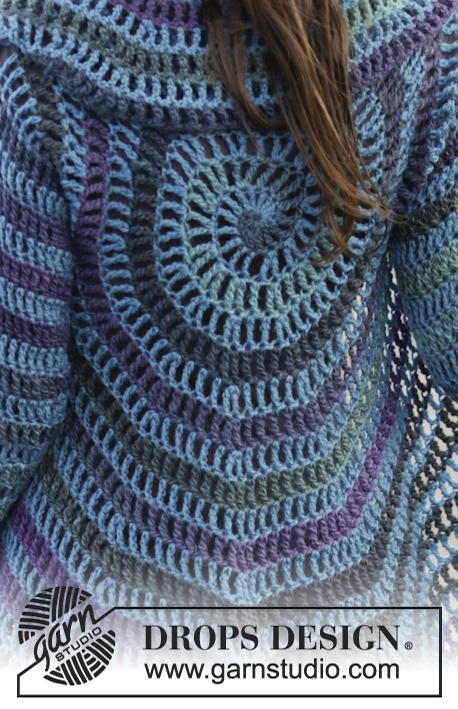

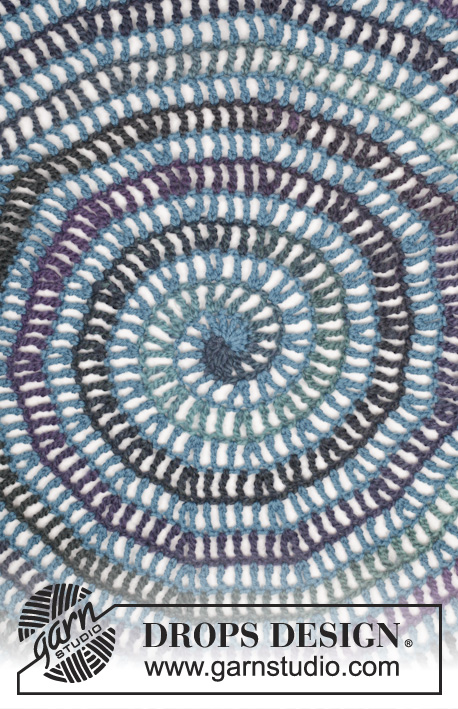


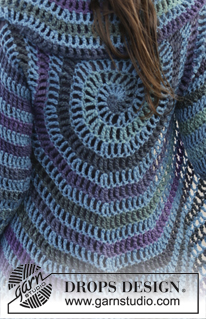
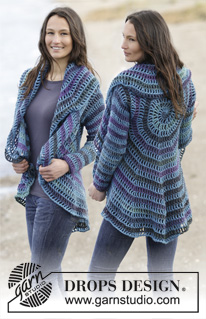




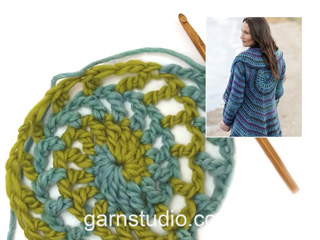
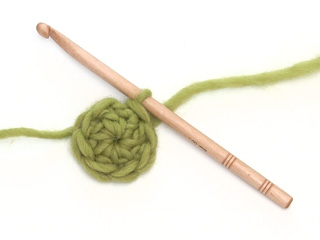
















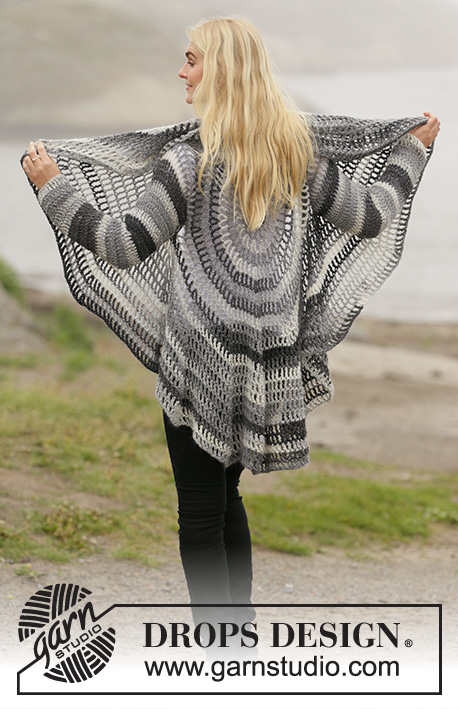
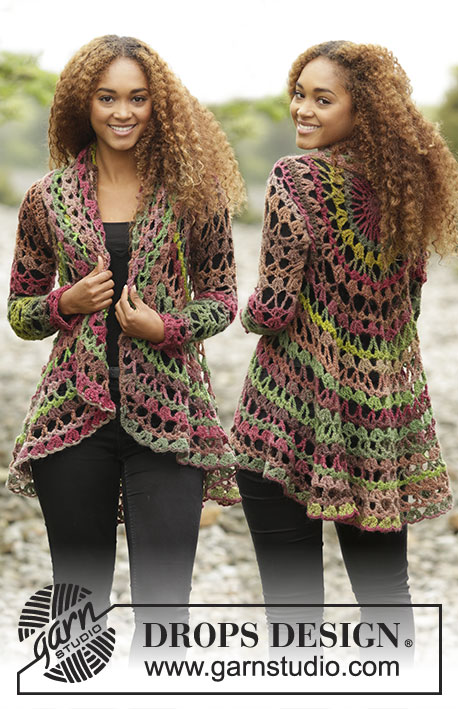






Comments / Questions (168)
Jeg tror jeg fandt ud af det. Tak
06.02.2021 - 12:35Så med en farve under ærmet, den anden over og så køre rundt som før?
06.02.2021 - 12:11DROPS Design answered:
Hei Malou-Cheanne. Så bra du fant det ut selv. God Fornøyelse videre.
12.02.2021 - 13:01Endnu en gang svarer I ikke på det, jeg faktisk spørger om... Hvor placerer jeg de 36? Og hvordan med skift af farve. De 36 skal jo laves med en og samme farve. Derefter ny farve en omgang osv. Er der nogen smart måde at gøre dette, eller skal jeg klippe garnet efter hver omgang? I må meget gerne svare på det, jeg spørger om denne gang. Mange tak.
03.02.2021 - 16:30DROPS Design answered:
Hej Malou, de 36 masker skal fordeles jævnt, det vil sige 18 masker på hver "side". Hvis du starter omgangen under ærmet, så kan du trække tråden med op til næste række, så behøver du ikke klippe tråden. Vi har også en video som viser hvordan man skifter farve / hækler striber :)
04.02.2021 - 14:32Jeg skal til at hækle ærmerne, men jeg er i tvivl om hvordan jeg gør. Det er str s. Jeg har 16 dbl-st (18 med dem i hjørnerne). På siden tættest mod midten, 1 RK i højde, 18 dbl-st (20 med hjørnerne) på rækken ved luftmaskerne. Hvor skal jeg placere de 36? Og skal alle være med en farve? Hvordan skifter jeg farve? Er det ved at klippe garnet hele tiden, hæfte, starte ny farve, klippe, hæfte osv?
29.01.2021 - 23:46DROPS Design answered:
Hej Malou, du hækler de 36 masker hele vejen rundt i ærmegabet (på samme måde som du hele tiden har gjort). Du skifter farve for hver omgang :)
03.02.2021 - 14:01Nach der 5. Runde steht in der Anleitung die 4. und 5. Runde fortlaufend wiederholen - heißt das ich arbeite jede Runde wieder 7x oder arbeite ich bis ich am Ende Runde bin ( ich würde dann nämlich bei der 1. Wiederholung der 4. Runde 14x arbeiten). 2te Frage: in jeder Runde ein D-Stb +1 Lm mehr zunehmen - bedeutet das wirklich nur mit einer Farbe ein D-Stb+1Lm oder mit beiden Farben - also 2 DStb+2lm/Runde
24.01.2021 - 09:02DROPS Design answered:
Liebe Eva, es wird wie zuvor gehäkelt: 1 Runde = 7 Mal mit jeder Wolle und gleichzeitig immer wie zuvor zunehmen, d.h. bei der 6. Runde (= wie 4. aber mit mehr Maschen zwischen Zunahmen): * je 1 D-Stb + 1 Lm in die 2 nächsten D-Stb, 1 D-Stb + 1 Lm + 1 D-Stb + 1 Lm in das nächste D-Stb *, von *-* insgesamt 7 x arb usw. Viel Spaß beim häkeln!
25.01.2021 - 09:42Hallo, ich würde gerne statt der 2 Farben - 3 verschiedene Farben verwenden - wie gehe ich da am besten vor ? danke und lg Eva
20.01.2021 - 16:42DROPS Design answered:
Liebe Eva, leider können wir nicht jede Anleitung nach jeder Anfrage anpassen - vielleicht könnnen Sie mal jede Runde entweder Halb mit jeder Farbe hier, jeweils 1/3 mit jeder Farbe? hier zeigen wir mit 4 Farben. Am besten versuchen Sie mit einer Maschenprobe, wie Sie es machen können. Viel Spaß beim häkeln!
21.01.2021 - 07:32Hallo, ich habe die 4. Und 5. Runde wie in der Anleitung beschrieben weiter gehäkelt bis ich die 140 DStb habe. Die Maschenmakierer sind so jeweils gegenüberliegend. Jetzt kommen die Armausschnitte und ich verstehe nicht wie weiter. Ich fange also mit irgendeiner Farbe an und wann wechsel ich zu der anderen? Das steht da nicht. Oder muss jeder Schritt in der anderen Farbe gemacht werden? 20 DStb in Karisma und dann die LM mit Big Delight?
21.10.2020 - 21:57DROPS Design answered:
Liebe Petra, bei der nächsten Runde, weiter wie zuvor mit dem Farbwechsel häkeln, aber keine Zunahmen bei dieser nächsten Runden arbeiten: die ersten 20 D-Stb mit 1 Lm wie zuvor, dann 32 Lm häkeln und die nächsten 20 Stb überspringen (= 1. Armloch), weiter wie zuvor bis 40 D-Stb vor der Ende der Runde bleiben, 32 Lm häkeln und die nächsten 20 Stb überpsringen (= 2. Armloch) und die Runde enden (= 20 Dstb mit 1 Lm dazwischen). Farbe/Garne wechseln Sie wie zuvor, die Hälfte der Runde muss - wie zuvor- mit je einer Farbe/einem Garn gehäkelt werden. Viel Spaß beim häkeln!
22.10.2020 - 10:22Hi. Lovely pattern. I just wanted to check, this uses a combination of an aran weight & DK yarn, as the yarns don't look a different weight in the photos. Also, you are using a washable yarn with a hand-wash yarn. Can you suggest an alternative mix that is all washable? Thanks.
28.09.2020 - 12:15DROPS Design answered:
Dear Mrs Tier, this pattern is worked with 2 different kind of yarn to get the right result - we use here DROPS Big Delight to play with colours - if you like a superwash yarn group C you can use instead DROP Big Merino or 2 strands DROPS Fabel (to play with colours too), but remember that it will look different because fibers/yarns are different - read more about alternatives here - you can use the yarn converter to check the other suggested alternatives. Happy knitting!
28.09.2020 - 12:40Working on this one now, this is so pretty - still working on the circle, then to the sleeves. Can't wait to complete and wear, and then do the Circle Jacket. Lovely patterns. Thank you for the tutorials they really help me get started.
08.08.2020 - 03:51I am stuck in the section were we are chaining in for the sleeves. I have 112 tr from the section before.And no matter what I do I end up with extra 16. I can't figure out were they go reading the instructions. Leave it for the front. Turn and start back or continue? Help confused!!!
05.05.2020 - 00:46DROPS Design answered:
Dear Kris, next round for armholes will be worked with the two yarns/colours as before but you won't increase on this round as you did before: Work 1 tr + 1 ch in each of the first 16tr, work 24 loose ch for armhole, skip the next 16 tr (this create a hole for armhole), work 1 tr + 1 ch in every tr until 32 tr remain on round, work 24 loose ch for armhole, skip the next 16 tr (2nd hole for 2nd armhole), work 1 tr + 1 ch in each of the last 16 tr. On next round, work as before with both yarns and increasing as explained for this round. Happy crocheting!
05.05.2020 - 11:28